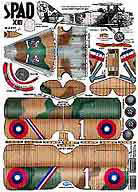
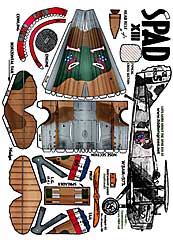
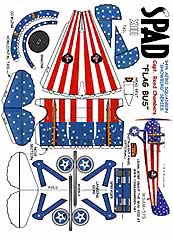
SPAD XIII - $$4.95
The SPAD XIII was a French biplane fighter aircraft of World War I, developed by Société Pour L'Aviation et ses Dérivés (SPAD) from the earlier highly successful SPAD S.VII. It was one of the most capable fighters of the war, and one of the most-produced, with 8,472 built and orders for around 10,000 more cancelled at the Armistice.
The WWI Scout SPAD 13 (XIII)
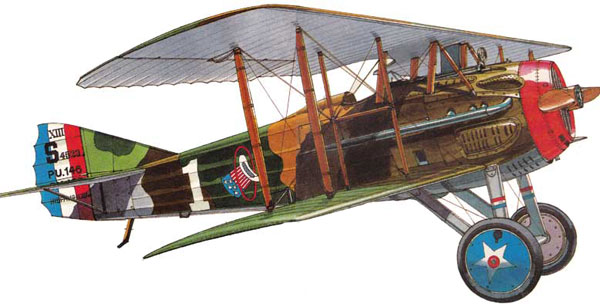
This is the single model webpage The Entire Collection is HERE
SPAD XIII: This is the robust French fighter that the American Ace Capt. Eddie Rickenbacker and his 'Hat in the Ring' Squadron made history. Produced in large quantity and flown by sharp pilots, It was one of the major factors to allied victory in WWI.Mike Smith sent in these really neat variations.
Re the SPAD 13 model: Lt. Ben Jones was my father. Unfortunately, he is no longer with us, but I am trying to get together as much information as possible on his WWI service for our family scrapbook. He served at the front with the squadron for only a couple of weeks before the armistice. I have pics of my father, but not of this "Zig Zag" plane. Ben Jones Jr. (Formerly a Lieutenant also)
Hi, You guys are full of surprises. I was snooping around the site and found 4 pretty new SPADs. I'm wondering if you are going to send out Magic Keys on these. Please, please, please. Thanks..Tim (April 27, 01)
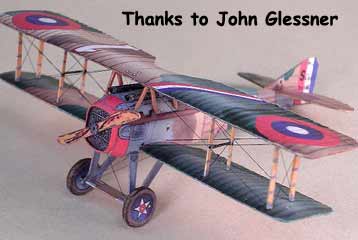 SPADS, SPADS, SPADS..I was sitting here at work, wondering
why I should go on and not just flush myself down the toilet.
Then I opened my mail and the reason was clear. Chip saved
my life again! Thanks for the spads. Roger
SPADS, SPADS, SPADS..I was sitting here at work, wondering
why I should go on and not just flush myself down the toilet.
Then I opened my mail and the reason was clear. Chip saved
my life again! Thanks for the spads. Roger
Chip, this is great! This is great! This is great! You guys are fantastic!! Tally Ho! Glenn R. (April 27, 01)
Funny colored Spads just absolutely spectacular. So very fa behind in models to do. You dig hole even deeper wit spiffy Spads. So talented. Sorry. Mind gone. I go now too......FP (apr 01)
I thought it prudent to reply to this latest magic key download and thank you and your colleagues for such a magnificent collection. With over seven months of future downloads to come I think that I'll still be making this lot in my retirement, without duplicating a single model, and that's still a good number of years away. Keep up the good work and don't forget my original suggestions for new models - civil airliners. Regards Martin
Spad VII & XIII
There can be no question that the SPAD scouts were the most successful French fighter aircraft of World War I. Indeed, many would say (and not only Frenchmen) that the SPAD was the flnest fighter produced by any nation at that time. Yet, like so many great airplanes, the SPAD twins, the Vll and the Xlll, had relatively humble beginnings. Before the war the Deperdussin company's brilliant young designer, Louis Bechereau, designed a sleek, braced wing monoplane with an ultra-streamlined fuselage, Known as the Monocoque, because of its fuselage construction, the Deperdussin was planned from the outset to go fast, lt did. ln its first year, 19 12, it won the Gordon Bennett Cup with a speed of l73.97km/h and the following year the Deperdussin racer captured the world air-speed record at 204 km/h.
Powering this stubby, but sleek little racer was a Gnome l4-cylinder rotary engine. The full name of the original Deperdussin company was the Societe des Produclions Armand Deperdussin, hence the name SPAD. Later, the company name was changed, but in such a way that the acronym SPAD could be retained.
However, the first aircraft to use the name hardly distinguished themselves. The A2 and A4 rejoiced in one of the most unconventional - and least successful - configurations in aviation history, They were tractor aircraft (i.e. the propeller was at the nose of the airplane and pulled it forward) but the observer/gunner was seated in front of the propeller, This arrangement was hardly popular with the crew but the idea was to get over the problem of firing through the propeller. lt was a freakish design and it didn't last.
ln April 1916, the SPAD Vll arrived. Designed by Bechereau, it was a conventional biplane in appearance,but it was immediately apparent that it could outperform the Nieuports that were then supplying the main fighter strength for the French Aviation Militaire. lt was also a much stronger aircraft all round. The first contract was awarded in the spring of 1916. Production started almost immediately and SPAD Vlls began to be delivered in September.
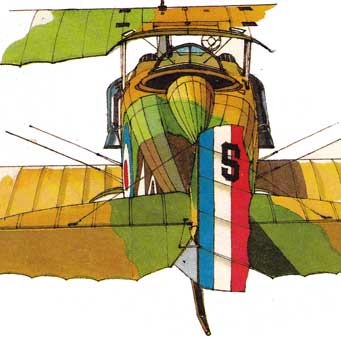 The SPAD Vll was powered by Marc Birkigt's marvellous new Hispano-Suiza water-cooled V8 engine which developed l50hp. Armament was a single 7.65mm Vickers offset to the right, using Birkigt synchronizing gear (no need to sit in front of the propeller now!). Fuel was carried under the lower wing in a fuselage tank specially curved to conform with the sleek fuselage lines, and a notable first for the SPAD Vll was the fact that this fuel could be lettisoned in an emergency.
The SPAD Vll was powered by Marc Birkigt's marvellous new Hispano-Suiza water-cooled V8 engine which developed l50hp. Armament was a single 7.65mm Vickers offset to the right, using Birkigt synchronizing gear (no need to sit in front of the propeller now!). Fuel was carried under the lower wing in a fuselage tank specially curved to conform with the sleek fuselage lines, and a notable first for the SPAD Vll was the fact that this fuel could be lettisoned in an emergency.
One of the very first SPAD Vlls to enter service was delivered to a 2l-year-old lieutenant inlhe Escadrtlle de Chasse N3. His name was Georges Guynemer. The fact that he claimed a victim on his second flight with the SPAD was remarkable; what was more unusual was that he shot down another three on a sortie only a few days later. However, this sad-looking young lieutenant was unusual. By the end of January, his total aircraft kills had reached 30, and because of this he christened his beloved SPAD La Mitrailleuse Volante, the Flying Machine Gun.
Georges Guynemer flew in good company. His fellow pilots in Escadrille N3 - the renamed SPAD but always known as Les Cigognes, or The Storks - included such aces as Capitaine Armand Pinsard (with 27 victories), Sous-Lieutenant Rene Dorme (with 23), Capitaine Alfred Herlaux (with 2l) and Capitaine Albert Deullin (with 20).
The SPAD Vll was so successful during this period that the other Allies all clamoured to use it. Many companies began to manufacture the Vll under licence, including two British-based companies, the British Bleriot and Spad Company at Brooklands and Mann Egerton in Norwich. Most of these British-built SPADs never found their way to the Western Front, Nevertheless, the SPAD served with great distinction in the Middle East, Belgium and ltaly, where Maggiore (Major) Francesco Baracca of the Gia Squadriglia achieved 23 of his 34 victories in SPADs,
before he was killed in action on June l9,l9l8.
However back in the spring of 1917, a new SPAD wa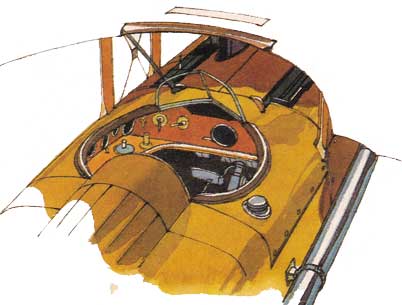 s demonstrated to the Fscadrilles de Chas{e. The SPAD Xlll was fltted with a more powerful Hispano-Suiza V8 engine which delivered 200hp. lt also carried two Vickers 7.65mm guns mounted above the engine. Georges Guynemer took delivery of one of these aircraft during the summer. His inevitable toll of victories seemed set to continue, but on I I September 1917 he disappeared while on a patrol over Poelcapelle, The great French ace of the war had claimed his last victim, with an amazing total of 54 confirmed kills. But as always, someone was ready to take his place. Rene Fonck, who was by now also flying a SPAD Xlll, had already shot down over 30 German aircraft, He went on to achieve a total score of 75 victories, makrng him the leading Allied ace, Eleven of his kills were gained with a SPAD fltted with a 37mm. cannon, firing through the hub of the propeller. Guynemer gained four victories with a similar aircraft.
s demonstrated to the Fscadrilles de Chas{e. The SPAD Xlll was fltted with a more powerful Hispano-Suiza V8 engine which delivered 200hp. lt also carried two Vickers 7.65mm guns mounted above the engine. Georges Guynemer took delivery of one of these aircraft during the summer. His inevitable toll of victories seemed set to continue, but on I I September 1917 he disappeared while on a patrol over Poelcapelle, The great French ace of the war had claimed his last victim, with an amazing total of 54 confirmed kills. But as always, someone was ready to take his place. Rene Fonck, who was by now also flying a SPAD Xlll, had already shot down over 30 German aircraft, He went on to achieve a total score of 75 victories, makrng him the leading Allied ace, Eleven of his kills were gained with a SPAD fltted with a 37mm. cannon, firing through the hub of the propeller. Guynemer gained four victories with a similar aircraft.
By March l9l 8, after Birkigt had made some hurried improvements to the new engine, which had proved somewhat unreliable, SPADs were being turned out at a remarkable rate and in fact, total French production of the aircraft reached 8472 by the time it stopped in l9l9. Around 14,700 were manufactured in total, outnumbering all other World War I flghters, American interest in the SPAD was spearheaded by the successes of their two great aces, Eddie Rickenbacker and Frank Luke. Rickenbacker scored the majority of his 26 victories in the SPADXIII, and the good reports he and his fellow Amcricans sent back resulted in the ambitious decision to build no less than 6000 SPADs in the United States.
The Armistice, of course, intervened in 1918. Notwrthstanding, the two SPAD's overall contribution to the Allies' fortunes cannot be overstated. They rank, along with the SE5 and the Camel, as the greatest Allied fighters of the entire war.
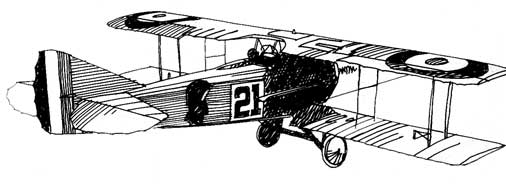

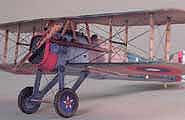 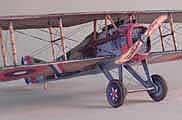 Thanks to John Glessner |
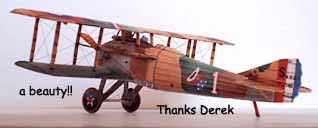 Thanks to Derek- (email me) |
 |
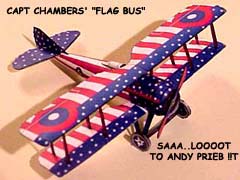 This version is included as a little bonus in this single SPAD model folder |
Specification for the Spad XIII
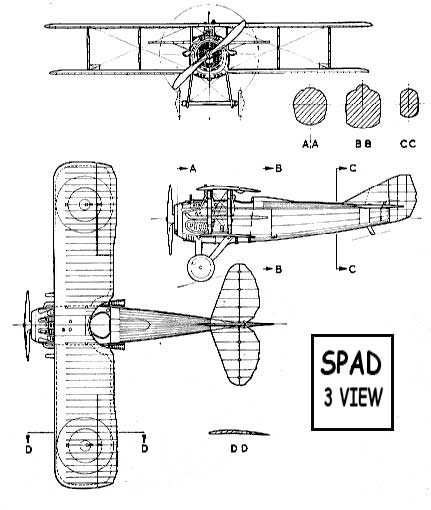 |
Country of origin: France, Engine: 150hp Hispano-Suiza 8Aa Wingspan: 25ft 6in Armament |
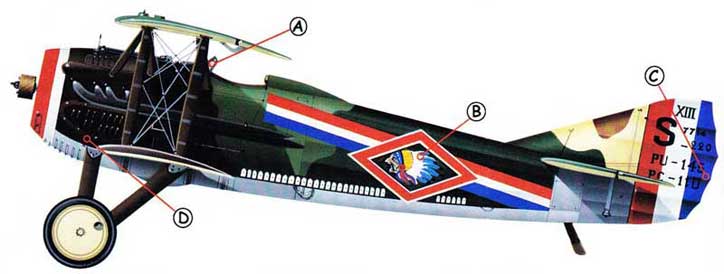 |
|||
| A: The SPAD was better armed than most Allied fighters, having two Vickers machine guns instead of the single gun of earlier types. The cockpit was very close to the upper wing surface. | B: The Lafayette Escadrille was an American staffed squadron consisting of volunteer pilots fighting in the French air force. The unit included such aces as Raoul Lufbery, who shot down 17 enemy aircraft. | C: Like the SPAD S.VII, the S.XII had a long sloping fin shape with a ribbed trailing edge. The aircraft had large, powerful rudder and elevator surfaces. | D: The SPAD was successful mainly because of the power of the Hispano-Suiza engine. The previous two-seat SPAD had suffered unreliability from its similar engine. |
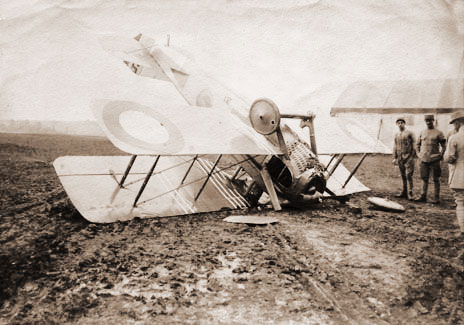
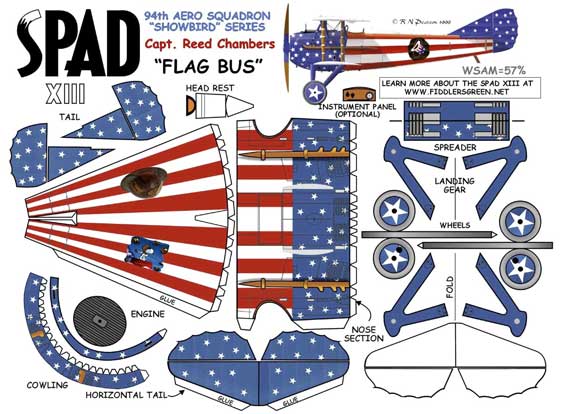
|


